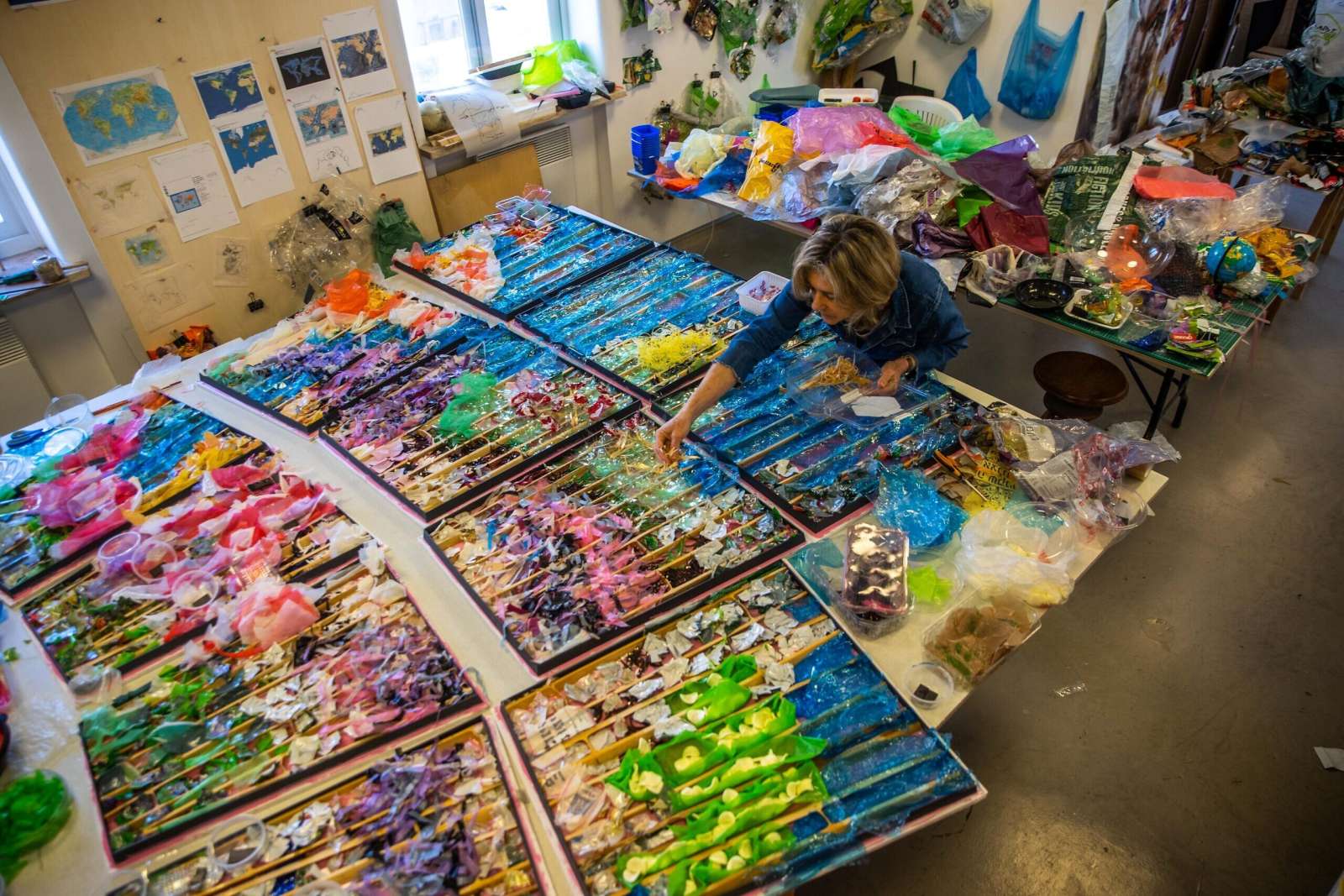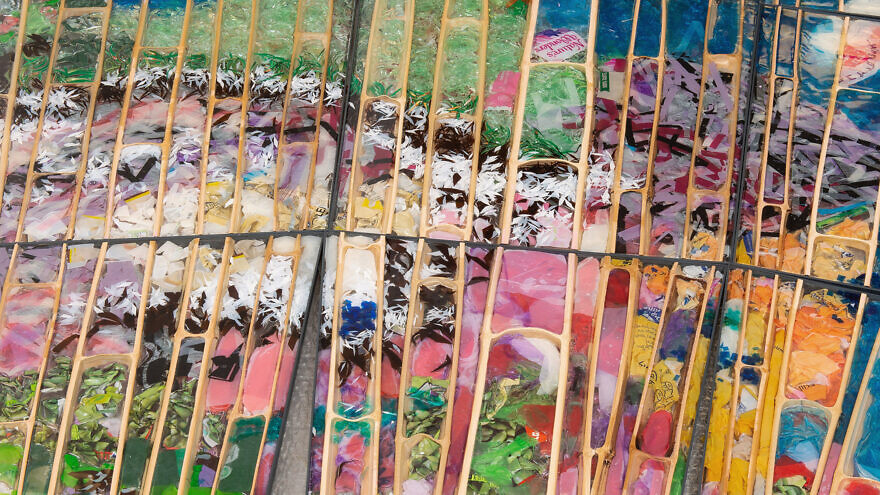“Warning: Plastic packets may be dangerous. Full stop.”
This is the typical warning label on those small plastic packets of silica gel that are tossed into food packaging, shoe boxes, electronics wrapping and more. Not only is the gel a toxin and potential choking hazard, but its plastic casing, tossed into the garbage bin, eventually settles into our soil and slowly releases toxic chemicals. Some of these bags make their way into our sewage systems and then our oceans, killing the animals who eat them.
A massive sculpture of the globe, “Earth Poetica” will be the highlight of her solo exhibition, which will open at the Gottesman Family Israel Aquarium in Jerusalem on Feb. 6. This is Barkat’s first solo exhibition in the country for five years.
“The sculpture is of the future,” she said. “It is Earth looking at Earth in the future.”
Barkat: ‘Is this our legacy?’
“Earth Poetica” is the coming together of eye-opening experiences that Barkat experienced in recent years, including seeing a television documentary about plastic waste.
“There were impoverished children searching for ‘treasure’ among piles of plastic waste on the beach. The image was so strong and has stayed with me,” said Barkat. “I was haunted by the images.”
Soon after seeing that film, Barkat—the wife of former Jerusalem Mayor Nir Barkat—was in her birthplace, South Africa, where she saw shores strewn with garbage. Barkat was horrified by the contrast between her childhood in the country, playing on the various beaches and picking up seashells, and the plastic piles on the beaches today.

“I asked myself, ‘Is this the beautiful earth that we are leaving for our children? Is this our legacy—planet Earth covered by plastic waste?’”
Around the same time, the World Trade Center commissioned Barkat to create a piece for one of its lobbies. She said that she went to see the specific site for which she had been asked to design a sculpture, and it was then that “Earth Poetica” was officially born.
Barkat realized she needed to create “art that makes an impact on people”—a piece with a “strong enough message of change that could carry itself from the World Trade Center into people’s personal lives. I said to myself, ‘this needs to be about the plastic problem.’”
That visit was more than three years ago, and Barkat has been working on “Earth Poetica” in Jerusalem ever since.
The sculpture, built from wrought iron with 180 panels of plastic stuck together with a soy-based resin and framed by natural split bamboo pieces, depicts the earth’s landmasses, seas and oceans in vibrant colors. From the outside, the plastic collage makes the globe shine like a precious gem. But through trapezoid openings, intentionally scattered throughout its shells, people can look inside the work and see that it is made of the same waste that is smothering Earth.
“The whole story is inside and outside,” Barkat explained. “You open yourself up to the piece because it is beautiful, it excites and interests you. You do not really know what it is made from. It is only when you come close that you see the graffiti, the ugliness of the plastic—plastics you threw into the garbage.”
Part of the sculpture is five plastic islands that sit in the middle of the world’s oceans. They are based on the real plastic patches that can be found today in the North and South Atlantic, the North and South Pacific and the Indian ocean.
“Because about 60% of the plastic islands are composed of refuse from fishing nets, the islands on my globe are also made of fishing nets,” Barkat said. Though she made these patches larger than they are now, because “they are growing, and growing and growing all the time.”

A studio strewn with plastics
To create the sculpture, Barkat collected plastic waste from around the world.
As an artist, before the coronavirus pandemic, she would travel for her work. Barkat said she started with plastic from Taiwan, England, Argentina and, of course, Israel.
But when travel ceased, she asked her family, friends and colleagues to assist her. Slowly, they sent a steady stream of plastic waste to her studio from wherever they were locked down. Barkat received plastic parcels in the mail from around the world—in distinct colors and consistencies and with labels in various languages.
“Companies invest so much money on the graphics that go on the plastic we purchase,” she said, “that is what I use for the sculpture.”
Sometimes she broke up the plastic so that its origin is unclear and other times she preserved the message, such as “Warning: Plastic packets may be dangerous. Full stop.” And still other times, she cut parts of messages, changing their meaning to accommodate her sculpture.
Even today, her studio is strewn with wrappers, cartons, bottles and bags.
A world-wide challenge
Plastic waste is an acute problem in Israel, where according to the Israeli NGO Adam Teva V’Din, Israelis produce 1.7 tons of waste per day, the equivalent of 625,000 tons per year. Only 14% of plastic waste is recycled. Another 60% is thrown away, according to the organization, and another more than 25% makes its way to the country’s beaches, seas and natural parks.
The 2019 National Marine Waste Monitoring Report showed that 90% of pollution on Israel’s beaches is derived from plastic, Adam Teva V’Din’s website states. Another study showed that plastic pollution was found in 20% of sampled fish in the Mediterranean since 2015.
Last year, following multiple delays, Israel expanded its Deposit Law to include bottles between 1.5 and five liters, charging a deposit fee now on all drink containers but enabling consumers to return these large bottles and receive the deposit fees paid at the time of purchase.
The law continues to be highly contested.

Around the world, the situation is equally as striking. A study by the MacArthur Foundation found that in 2025 the oceans will contain a ton of plastic for every ton of fish, and by 2050 the amount of plastic will surpass that of fish due to the huge proportion of the 10 million tons of plastics finding their way to the oceans, Barkat said.
Plastic pollution in the world’s oceans costs society up to $2.5 trillion a year, according to a study published in the Marine Pollution Bulletin recently and quoted by the website Waste360.
Moreover, the World Health Organization has warned that because plastic does not fully degrade, tiny pieces of plastic, known as “microplastics,” end up everywhere—including in drinking water, exposing people to dangerous toxins that can by some reports can cause cancers, liver and kidney damage over time.
Although WHO has said that more research is needed and that water treatment can effectively remove more than 90% of microplastics from our drinking water, it recommended minimizing plastic usage.
“Earth Poetica” tries to capture this dialogue.
“‘Earth Poetica’ is both personal and collective aesthetic questioning by the artist about our present and future time on planet Earth,” said Raffaella Frascarelli, who is curating Barkat’s exhibit and serves as the scientific director of the Nomas Foundation, an arts foundation in Rome. “It is an unequivocally original and masterly visual translation not only of the scale of the plastic pollution, but also of the interconnectedness of humankind, its fragile relationship with nature and the vulnerability of humankind itself.”
Barkat said that she purposefully placed plastics from one part of the world in another area to demonstrate how plastic moves from one place to another and how humans are interconnected and must work together to solve the plastics crisis.

“When COVID broke out, we were all isolated in our homes and our countries,” Barkat told JNS. “But even as we tried to isolate, the virus was still able to penetrate. Nature does not have borders. Borders are man-made. ‘Earth Poetica’ is about everyone together.”
The Jerusalem aquarium, she said, represents this interconnectedness for Israel, as it is a place where haredim, Arabs, secular and religious Jews and Christians all visit with their children.
“I hope that ‘Earth Poetica’ engages the many diverse visitors to the aquarium, and in particular children who need to know about the future of our planet,” she said. “The power to effect change will be in their hands, and the solutions as well.”
But Barkat stressed that she is not giving a solution for how to tackle the problem. Rather, she is posing a question and opening up a debate. “My hope is to create some kind of dialogue that will enable change,” she said.
With all the plastic that still remains in her downtown studio, she said a second project is simmering.
“Maybe I will just leave the plastic here for the moment,” Barkat said, “and see what it develops into.”


























